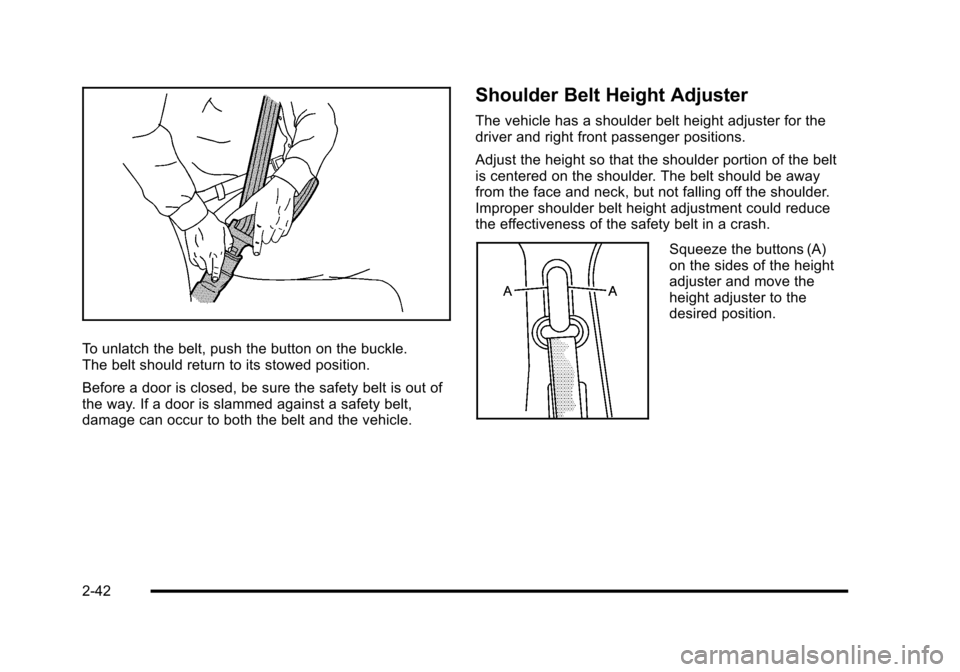height CADILLAC ESCALADE 2010 3.G Owners Manual
[x] Cancel search | Manufacturer: CADILLAC, Model Year: 2010, Model line: ESCALADE, Model: CADILLAC ESCALADE 2010 3.GPages: 616, PDF Size: 39.41 MB
Page 14 of 616

Raise or lower the entire seat by moving the entirecontrol up or down.
SeePower Seats on page 2!4.
Power Lumbar
To increase lumbar support, press and hold the frontof the control. To decrease, press and hold the rear ofthe control.
To raise the height of the support, press and hold thetop of the control. To lower, press and hold the bottomof the control.
SeePower Lumbar on page 2!5.
Power Reclining Seatbacks
To recline the seatback, tilt the top of the controlrearward.
To bring the seatback forward, tilt the top of the controlforward.
SeePower Reclining Seatbacks on page 2!8.
1-8
Page 34 of 616

Head Restraints
The front seats have adjustable head restraints in theoutboard seating positions.
{CAUTION:
With head restraints that are not installed and
adjusted properly, there is a greater chance that
occupants will suffer a neck/spinal injury in a
crash. Do not drive until the head restraints for all
occupants are installed and adjusted properly.
Adjust the head restraint so that the top of the restraintis at the same height as the top of the occupant's head.This position reduces the chance of a neck injury ina crash.
2-2
Page 37 of 616

Power Lumbar
The controls used to operate the power lumbar featureare located on the outboard side of the seats.
.To increase lumbar support, press and hold thefront of the control.
.To decrease lumbar support, press and hold therear of the control.
.To raise the height of the support, press and holdthe top of the control.
.To lower the height of the support, press and holdthe bottom of the control.
Let go of the control when the lower seatback reachesthe desired level of support.
Your vehicle has a memory function which allows seatsettings to be saved and recalled. SeeMemoryFeatureso n p a g e 2!6for more information.
Keep in mind that as your seating position changes, asit may during long trips, so should the position of yourlumbar support. Adjust the seat as needed.
Heated and Cooled Seats
If the front seats have theheated and cooled seatfeature, the buttons usedto control this feature arelocated on the climatecontrol panel.
{(Cooled Seat):To cool the entire seat, press thebutton with the cooled seat symbol.
2-5
Page 73 of 616

3. Push the latch plate into the buckle until it clicks.If you find that the latch plate will not go fully intothe buckle, see if you are using the correct buckle.
Pull up on the latch plate to make sure it is secure.If the belt is not long enough, seeSafety BeltExtenderon page 2!48.
Position the release button on the buckle so thatthe safety belt could be quickly unbuckled ifnecessary.
4. If equipped with a shoulder belt height adjuster,move it to the height that is right for you. See“Shoulder Belt Height Adjustment”later in thissection for instructions on use and important safetyinformation.
5. To make the lap part tight, pull up on theshoulder belt.
It may be necessary to pull stitching on the safetybelt through the latch plate to fully tighten the lapbelt on smaller occupants.
2-41
Page 74 of 616

To unlatch the belt, push the button on the buckle.The belt should return to its stowed position.
Before a door is closed, be sure the safety belt is out ofthe way. If a door is slammed against a safety belt,damage can occur to both the belt and the vehicle.
Shoulder Belt Height Adjuster
The vehicle has a shoulder belt height adjuster for thedriver and right front passenger positions.
Adjust the height so that the shoulder portion of the beltis centered on the shoulder. The belt should be awayfrom the face and neck, but not falling off the shoulder.Improper shoulder belt height adjustment could reducethe effectiveness of the safety belt in a crash.
Squeeze the buttons (A)on the sides of the heightadjuster and move theheight adjuster to thedesired position.
2-42
Page 81 of 616

Child Restraints
Older Children
Older children who have outgrown booster seats shouldwear the vehicle's safety belts.
The manufacturer's instructions that come with thebooster seat, state the weight and height limitations forthat booster. Use a booster seat with a lap-shoulder beltuntil the child passes the below fit test:
.Sit all the way back on the seat. Do the kneesbend at the seat edge? If yes, continue. If no,return to the booster seat.
.Buckle the lap-shoulder belt. Does the shoulderbelt rest on the shoulder? If yes, continue. If no, tryusing the rear safety belt comfort guide. See“RearSafety Belt Comfort Guides”underLap-ShoulderBelton page 2!39for more information. If theshoulder belt still does not rest on the shoulder,then return to the booster seat.
.Does the lap belt fit low and snug on the hips,touching the thighs? If yes, continue. If no, returnto the booster seat.
.Can proper safety belt fit be maintained for lengthof trip? If yes, continue. If no, return to thebooster seat.
If you have the choice, a child should sit in a positionwith a lap-shoulder belt and get the additional restrainta shoulder belt can provide.
2-49
Page 86 of 616

Q: What are the different types of add-on childrestraints?
A:Add-on child restraints, which are purchased by thevehicle's owner, are available in four basic types.Selection of a particular restraint should take intoconsideration not only the child's weight, height, andage but also whether or not the restraint will becompatible with the motor vehicle in which it willbe used.
For most basic types of child restraints, there aremany different models available. When purchasing achild restraint, be sure it is designed to be used in amotor vehicle. If it is, the restraint will have a labelsaying that it meets federal motor vehicle safetystandards.
The restraint manufacturer's instructions that comewith the restraint state the weight and heightlimitations for a particular child restraint. In addition,there are many kinds of restraints available forchildren with special needs.
{WARNING:
To reduce the risk of neck and head injury during
a crash, infants need complete support. This is
because an infant's neck is not fully developed
and its head weighs so much compared with
the rest of its body. In a crash, an infant in a
rear-facing child restraint settles into the restraint,
so the crash forces can be distributed across the
strongest part of an infant's body, the back and
shoulders. Infants should always be secured in
rear-facing child restraints.
2-54
Page 121 of 616

Servicing Your Airbag-Equipped
Vehicle
Airbags affect how the vehicle should be serviced.There are parts of the airbag system in several placesaround the vehicle. Your dealer/retailer and the servicemanual have information about servicing the vehicleand the airbag system. To purchase a service manual,seeService Publications Ordering Informationonpage 9!17.
{WARNING:
For up to 10 seconds after the ignition is turned off
and the battery is disconnected, an airbag can still
inflate during improper service. You can be injured
if you are close to an airbag when it inflates. Avoid
yellow connectors. They are probably part of the
airbag system. Be sure to follow proper service
procedures, and make sure the person performing
work for you is qualified to do so.
Adding Equipment to Your
Airbag-Equipped Vehicle
Q: Is there anything I might add to or change aboutthe vehicle that could keep the airbags fromworking properly?
A:Yes. If you add things that change the vehicle'sframe, bumper system, height, front end or sidesheet metal, they may keep the airbag system fromworking properly. Changing or moving any parts ofthe front seats, safety belts, the airbag sensing anddiagnostic module, steering wheel, instrument panel,roof-rail airbag modules, ceiling headliner or pillargarnish trim, overhead console, front sensors, sideimpact sensors, rollover sensor module, or airbagwiring can affect the operation of the airbag system.
In addition, the vehicle may have a passengersensing system for the right front passengerposition, which includes sensors that are part of thepassenger seat. The passenger sensing systemmay not operate properly if the original seat trim isreplaced with non-GM covers, upholstery or trim,or with GM covers, upholstery or trim designed for a
2-89
Page 173 of 616

SBZA Detection Zones
The SBZA sensor covers a zone of approximatelyone lane over from both sides of the vehicle,3.5 m (11 ft). This zone starts at each side mirror andgoes back approximately 16 ft. (5.0 m). The height ofthe zone is approximately between 0.5 m (1.5 ft) and2.0 m (6 ft) off the ground.
Use caution while changing lanes when towing a trailer,as the SBZA detection zones do not change when atrailer is towed.
How the System Works
Left Side Mirror DisplayRight Side Mirror Display
When the vehicle is started, both outside mirrordisplays will briefly come on to indicate that the systemis operating. When the vehicle is moving forward, theleft or right side mirror SBZA display will light up if avehicle is detected in that blind zone.
If the turn signal is activated and a vehicle is alsodetected on the same side, the SBZA display will flashto give you extra warning not to change lanes.
SBZA displays do not come on while the vehicle isapproaching or passing other vehicles. At speedsgreater then 32 km/h (20 mph), SBZA displays maycome on when a vehicle you have passed remains in ordrops back into the detection zone.
SBZA can be disabled through the Driver InformationCenter (DIC). SeeDriver Information Center (DIC)onpage 4!41for more information. If the SBZA is disabledby the driver, the SBZA mirror displays will not light upduring normal driving.
When the System Does Not Seem To Work
Properly
Occasional missed alerts can occur under normalcircumstances and will increase in wet conditions.The system does not need to be serviced due to anoccasional missed alert. The number of missed alertswill increase with increased rainfall or road spray.
If the SBZA displays do not light up when the system ison and vehicles are in the blind zone, the system mayneed service. Take the vehicle to your dealer/retailer.
3-49
Page 427 of 616

If you put things inside your vehicle—like
suitcases, tools, packages, or anything
else—they will go as fast as the vehicle goes.
If you have to stop or turn quickly, or if there is a
crash, they will keep going.
{WARNING:
Things you put inside your vehicle can strike
and injure people in a sudden stop or turn,
or in a crash.
.Put things in the cargo area of your
vehicle. Try to spread the weight evenly.
.Never stack heavier things, like
suitcases, inside the vehicle so that some
of them are above the tops of the seats.
.Do not leave an unsecured child restraint
in your vehicle.
.When you carry something inside the
vehicle, secure it whenever you can.
.Do not leave a seat folded down unless
you need to.
There is also important loading information for
off-road driving in this manual. See“Loading Your
Vehicle for Off-Road Driving”underOff-Road
Drivingon page 6!13.
Add-On Equipment
When you carry removable items, you may need
to put a limit on how many people you can carry
inside your vehicle. Be sure to weigh your vehicle
before you buy and install the new equipment.
Notice :Overloading the vehicle may cause
damage. Repairs would not be covered by the
vehicle warranty. Do not overload the vehicle.
Remember not to exceed the Gross Axle Weight
Rating (GAWR) of the front or rear axle.
Automatic Level Control
The automatic level control rear suspension
comes as a part of the Road Sensing Suspension.
SeeRoad Sensing Suspensionon page 6!9.
This type of level control is fully automatic and will
provide a better leveled riding position as well as
better handling under a variety of passenger and
loading conditions. An air compressor connected
to the rear shocks will raise or lower the rear of
the vehicle to maintain proper vehicle height.
6-37